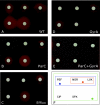Nonmolecular test for detection of low-level resistance to fluoroquinolones in Streptococcus pneumoniae
- PMID: 16436712
- PMCID: PMC1366886
- DOI: 10.1128/AAC.50.2.572-579.2006
Nonmolecular test for detection of low-level resistance to fluoroquinolones in Streptococcus pneumoniae
Abstract
With respect to pneumococci, there is a need to detect first-step mutants with reduced fluoroquinolone (FQ) susceptibility from which second-step, resistant mutants are likely to be selected in the presence of antipneumococcal FQs. Here, we describe an interpretative disk diffusion test, of which three options are presented, that allows the distinction between first- and second-step mutants. Using five FQ disks (pefloxacin, norfloxacin, levofloxacin, ciprofloxacin, and sparfloxacin, option 1), all known mechanisms of altered FQ susceptibility found in first-step mutants (ParC, ParE, GyrA, or efflux) and in second-step mutants (ParC and GyrA or ParE and GyrA) can be accurately detected, making this option a useful epidemiological tool. Using three FQ disks (pefloxacin, norfloxacin, and levofloxacin, option 2), the most prevalent FQ-resistant mutants, but not the first-step GyrA mutants, can be detected. With only two FQ disks (norfloxacin and levofloxacin) in the third and simplest option, first-step mutants can be distinguished from second-step mutants, however, without differentiation of ParC, ParE, or efflux alterations.
Figures


Similar articles
-
Mutant prevention concentrations for single-step fluoroquinolone-resistant mutants of wild-type, efflux-positive, or ParC or GyrA mutation-containing Streptococcus pneumoniae isolates.Antimicrob Agents Chemother. 2004 Oct;48(10):3954-8. doi: 10.1128/AAC.48.10.3954-3958.2004. Antimicrob Agents Chemother. 2004. PMID: 15388458 Free PMC article.
-
In vitro activity of older and newer fluoroquinolones against efflux-mediated high-level ciprofloxacin-resistant Streptococcus pneumoniae.Int J Antimicrob Agents. 2004 Aug;24(2):185-7. doi: 10.1016/j.ijantimicag.2004.01.012. Int J Antimicrob Agents. 2004. PMID: 15288320
-
ParC and GyrA may be interchangeable initial targets of some fluoroquinolones in Streptococcus pneumoniae.Antimicrob Agents Chemother. 1999 Feb;43(2):302-6. doi: 10.1128/AAC.43.2.302. Antimicrob Agents Chemother. 1999. PMID: 9925523 Free PMC article.
-
In vivo pharmacodynamic efficacy of gatifloxacin against Streptococcus pneumoniae in an experimental model of pneumonia: impact of the low levels of fluoroquinolone resistance on the enrichment of resistant mutants.J Antimicrob Chemother. 2004 Sep;54(3):640-7. doi: 10.1093/jac/dkh393. Epub 2004 Aug 18. J Antimicrob Chemother. 2004. PMID: 15317743
-
Fluoroquinolone antibiotics: Occurrence, mode of action, resistance, environmental detection, and remediation - A comprehensive review.Environ Pollut. 2022 Dec 15;315:120440. doi: 10.1016/j.envpol.2022.120440. Epub 2022 Oct 17. Environ Pollut. 2022. PMID: 36265724 Review.
Cited by
-
Resistance surveillance studies: a multifaceted problem--the fluoroquinolone example.Infection. 2012 Jun;40(3):239-62. doi: 10.1007/s15010-012-0257-2. Epub 2012 Mar 30. Infection. 2012. PMID: 22460782 Review.
-
Real-time PCR detection of gyrA and parC mutations in Streptococcus pneumoniae.Antimicrob Agents Chemother. 2008 Nov;52(11):4155-8. doi: 10.1128/AAC.00082-08. Epub 2008 Aug 25. Antimicrob Agents Chemother. 2008. PMID: 18725440 Free PMC article.
-
Fatal levofloxacin failure in treatment of a bacteremic patient infected with Streptococcus pneumoniae with a preexisting parC mutation.J Clin Microbiol. 2008 Apr;46(4):1558-60. doi: 10.1128/JCM.02066-07. Epub 2008 Feb 20. J Clin Microbiol. 2008. PMID: 18287316 Free PMC article.
-
Comparison of prognostic factors between bacteraemic and non-bacteraemic critically ill immunocompetent patients in community-acquired severe pneumococcal pneumonia: a STREPTOGENE sub-study.Ann Intensive Care. 2021 Oct 24;11(1):148. doi: 10.1186/s13613-021-00936-z. Ann Intensive Care. 2021. PMID: 34689255 Free PMC article.
-
Host-pathogen interactions and prognosis of critically ill immunocompetent patients with pneumococcal pneumonia: the nationwide prospective observational STREPTOGENE study.Intensive Care Med. 2018 Dec;44(12):2162-2173. doi: 10.1007/s00134-018-5444-x. Epub 2018 Nov 19. Intensive Care Med. 2018. PMID: 30456466
References
-
- Chen, D. K., A. McGeer, J. C. de Azavedo, D. E. Low, et al. 1999. Decreased susceptibility of Streptococcus pneumoniae to fluoroquinolones in Canada. N. Engl. J. Med. 341:233-239. - PubMed
-
- Davidson, R., R. Cavalcanti, J. L. Brunton, D. J. Bast, J. C. de Azavedo, P. Kibsey, C. Fleming, and D. E. Low. 2002. Resistance to levofloxacin and failure of treatment of pneumococcal pneumonia. N. Engl. J. Med. 346:747-750. - PubMed
-
- Davies, T. A., A. Evangelista, S. Pfleger, K. Bush, D. F. Sahm, and R. Goldschmidt. 2002. Prevalence of single mutations in topoisomerase type II genes among levofloxacin-susceptible clinical strains of Streptococcus pneumoniae isolated in the United States in 1992 to 1996 and 1999 to 2000. Antimicrob. Agents Chemother. 46:119-124. - PMC - PubMed
Publication types
MeSH terms
Substances
LinkOut - more resources
Full Text Sources
Other Literature Sources

